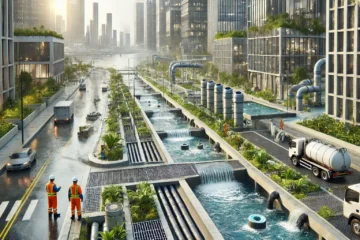Wind Energy: A Breath of Fresh Air for Renewable Energy
Wind energy, a clean and renewable energy source, harnesses the power of the wind to generate electricity. Wind turbines convert the kinetic energy of the wind into mechanical energy, which is then used to drive generators.
How Wind Energy Works:
- Wind Turbine Structure: A wind turbine consists of a tower, a nacelle, and rotor blades.
- Wind Capture: The rotor blades capture the kinetic energy of the wind.
- Mechanical Energy Conversion: The blades rotate, turning the turbine’s shaft.
- Electrical Energy Generation: The mechanical energy is converted into electrical energy by a generator.
- Power Transmission: The generated electricity is transmitted to the grid through power lines.
Advantages of Wind Energy:
- Clean and Renewable: Wind energy produces no greenhouse gas emissions.
- Abundant Resource: Wind is a renewable resource that is widely available.
- Low Operating Costs: Once a wind farm is built, the operating costs are relatively low.
- Job Creation: The wind energy industry creates jobs in manufacturing, installation, and maintenance.
- Economic Benefits: Wind energy can contribute to economic growth and energy independence.
Challenges of Wind Energy:
- Intermittency: Wind speed and direction can vary, affecting electricity generation.
- Visual Impact: Wind turbines can be visually disruptive, especially in rural areas.
- Noise Pollution: Wind turbines can generate noise, which may be a concern for nearby residents.
- Initial Costs: The initial investment in wind farms can be high.
The Future of Wind Energy:
Wind energy is a rapidly growing industry, with significant potential for future growth. Advancements in technology, such as larger and more efficient turbines, are helping to reduce costs and improve performance. As the world transitions to a low-carbon future, wind energy will play a crucial role in meeting our energy needs
Environmental Impact of Wind Farms:
While wind energy is a clean and renewable energy source, it’s important to consider its potential environmental impacts:
- Visual Impact: Large wind farms can be visually disruptive, especially in rural areas.
- Noise Pollution: Wind turbines can generate noise, which may affect nearby residents.
- Bird and Bat Mortality: Wind turbines can pose a risk to birds and bats, particularly during migration.
- Electromagnetic Interference: Wind turbines can interfere with radio and television signals.
To mitigate these impacts, careful planning and site selection are crucial. Additionally, measures such as bird and bat deterrent systems can be implemented to reduce wildlife fatalities.
Wind energy is a rapidly growing industry, with significant potential for future growth. Advancements in technology, such as larger and more efficient turbines, are helping to reduce costs and improve performance. As the world transitions to a low-carbon future, wind energy will play a crucial role in meeting our energy needs.


